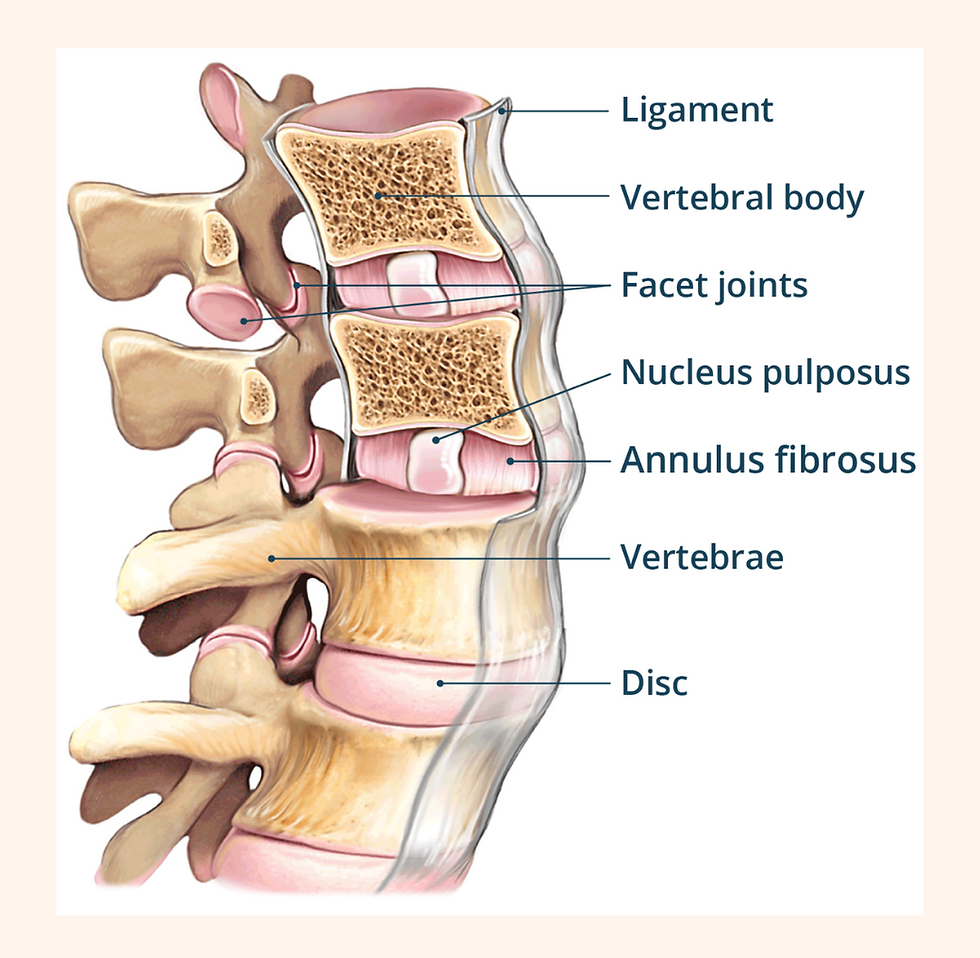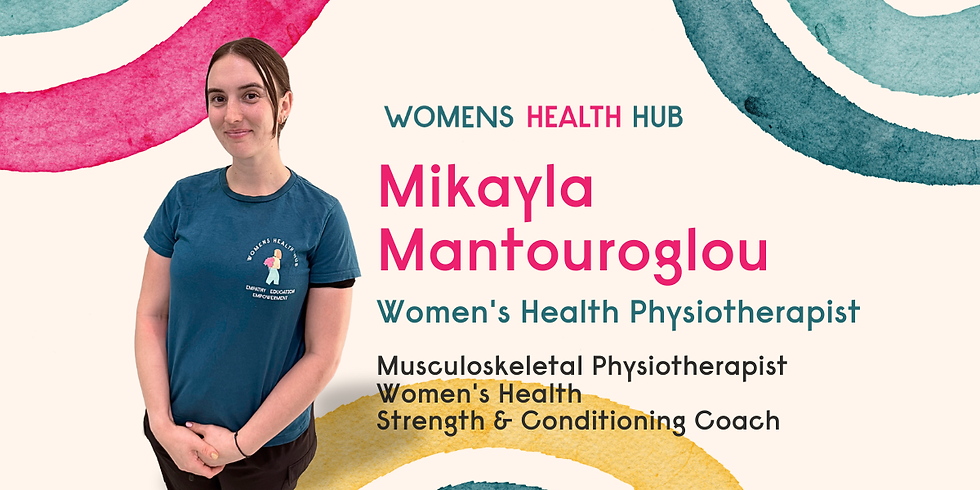Low Back Pain Symptoms and Causes
- Mikayla Mantouroglou

- Oct 14
- 5 min read

Key Highlights:
Low back pain is very common. It is the pain in the area below your ribs and above your bottom creases.
Back pain can last for different lengths of time: acute pain lasts a few days to weeks, subacute pain lasts up to 12 weeks, while chronic pain lasts more than 3 months.
Most back pain is “non-specific,” meaning there isn’t a single clear cause, but in some cases, it can be linked to specific issues like a disc herniation, arthritis, spinal changes such as narrowing, or fractures.
Several factors increase the risk of developing low back pain, including age, being overweight, low fitness or a sedentary lifestyle, smoking, poor posture, and jobs that involve heavy lifting, long sitting, or repetitive strain.
Most cases of low back pain improve with time, guided movement, posture awareness, and simple self-care.
What is Low Back Pain?
Low back pain is something most people will experience at some point in their lives. The lower back, also known as the lumbar spine, is the part of your back below the ribs. The low back is an area of movement, load-bearing, and stability, made up of vertebrae, discs, joints, ligaments, and muscles. Because it supports much of the body’s weight and enables flexibility, it is especially prone to stress and strain.

Research shows that around 16% of Australians, about 4 million people, are living with back problems right now, and studies show that 70–90% of people will experience low back pain at least once in their lifetime.
It can affect anyone, men or women, young or elderly, and while the intensity and duration may vary, it often becomes a major reason people take time off work or limit their daily activities and social interaction.
Research suggests that between 10% and 40% of adults with low back pain may go on to develop ongoing or disabling symptoms that can affect daily activities.
Low back pain can feel very different from person to person. For some, it’s mild and settles quickly. For others, it may come on suddenly, spread across a wider area, and make even simple movements uncomfortable.
The way we describe back pain often depends on how long it lasts:
Acute pain: Lasts a few days to a few weeks. This is the most common type and often improves with simple self-care, though it can feel quite severe at times and be debilitating.
Subacute pain: Lasts between 4 to 12 weeks. This means it is taking longer then expected to heal but is not yet chronic. Management can make a huge difference here (hint: see a Physio to ensure appropriate assessment and treatment).
Chronic pain: Lasts for 3 months or longer, even after the original cause has healed. About 1 in 5 people who develop acute pain may go on to experience chronic pain, which can be harder to manage and sometimes affect quality of life.
Most cases of low back pain improve over time, especially with gentle movement, posture awareness, and simple self-care. When pain lingers or becomes more severe, seeking professional guidance is important, as there are effective ways to manage symptoms and support long-term recovery.
Low Back Pain Symptoms
Low back pain can appear in different ways and affect more than just the back itself. Some of the most common symptoms include:
Pain and soreness. For some, it shows up as a sharp, stabbing pain, while for others it may be a dull ache or muscle spasms.
Stiffness. You may feel limited in your movement, making it harder to bend, twist, or carry out simple daily activities.
Nerve-related changes. When the nerves are involved, people may notice tingling, numbness, pins and needles, or even weakness in the leg.
Sciatic pain. It is a type of nerve pain that travels down one or both legs and, in some cases, extends into the foot.

Low back pain can also influence emotional wellbeing:
Irritability or changes in mood
Worry that the pain may not improve
Feelings of frustration or helplessness, especially when pain persists
In rare cases, back pain can be a sign of something more serious, such as an infection or a spinal fracture. These situations may cause additional symptoms like:
Redness, swelling, or warmth in the affected area
Feeling generally unwell
By now you should understand that low back pain can range from mild to severe, and it may begin suddenly after an injury or develop gradually over time.
Low Back Pain Causes
The lower back is a strong area of the body. It’s built from bones, discs that cushion movement, small joints that help you bend and twist, and many layers of muscles and ligaments that keep everything supported. The spinal column protects the spinal cord and nerves branching from it, this structure enables signals between the brain and body. A disruption such as an injury to the lower back may result in increased pain due to neural involvement.
We generally classify low back pain into two main types:
1. Non-specific low back pain
In most cases, a clear cause for low back pain can’t be identified. This is called non-specific back pain. While that might sound frustrating, it’s actually reassuring because it usually means the pain is not related to a serious medical problem.
Non-specific low back pain is most common in people aged 35 to 55 years, but can affect people of all ages. Factors that can worsen non-specific back pain include:
Muscle or ligament strain (often from lifting, twisting, or poor posture)
Joint irritation, such as at the facet joints
Myofascial pain (tight knots or trigger points in muscles)
Stress, which can increase muscle tension and amplify pain
Non-specific pain is usually managed with activity modification, guided exercise and simple treatments rather than complex testing.
2. Specific low back pain

This is when a definite cause can be identified, such as:
Disc herniation (you may have heard the terms disc bulge or slipped this is incorrect terminology)
Lumbar spinal stenosis (narrowing of the spinal canal)
Degenerative disc disease (changes in your spinal discs as you age)
Radiculopathy (nerve compression)
Spondylolisthesis (slippage of one vertebra over another)
Osteoarthritis or ankylosing spondylitis (may cause spondylitis, inflammation of the vertebrae)
Spondylosis (wear-and-tear or degeneration of the spine)
Spondylolysis (small stress fracture or defect in a vertebra)
Osteoporosis and spinal fractures
Scoliosis or other spinal deformities
Infections, tumors, or skeletal metastases
Cauda equina syndrome (a rare but serious condition requiring urgent attention, affects the bowel and bladder function)
Specific causes are less common but important to recognise because they may need targeted investigation or treatment.
Other temporary causes of low back pain
Sometimes back pain is short-term and linked to natural processes in the body, such as:
Menstrual cramps: Some people experience low back cramps during their period.
Pregnancy: Low back pain is common, especially in the second and third trimesters. Hormonal changes, extra weight, and a shifting center of gravity all play a role.
Back labor: Pain and discomfort in the lower back during labor, often when the baby's posterior presentation, facing the belly instead of the back.
Who Gets Low Back Pain?
Low back pain can affect anyone, at any age. Most people experience their first episode between the ages of 20 and 40, but it can occur earlier or later in life.

Some people are more likely to develop low back pain because of certain risk factors, such as:
Age: The risk increases as we get older.
Sedentary lifestyle or low fitness levels: Weak core or back muscles can make the spine more vulnerable.
Being overweight: Extra weight places added strain on the lower back.
Work and activities: Jobs that involve heavy lifting, pushing, pulling, twisting, or long periods of vibration (such as truck driving) can contribute to pain. Desk jobs can also increase risk, especially with poor posture or inadequate back support.
Other lifestyle factors:
Smoking
Prolonged sitting
Physically demanding work
Low back pain is common and, while it can sometimes linger, most cases aren’t caused by anything serious. Understanding the causes, symptoms, and risk factors is the first step in managing it well. In the next part, we’ll explore how physiotherapy can play an important role in easing pain, restoring movement, and supporting long-term recovery.








Comments